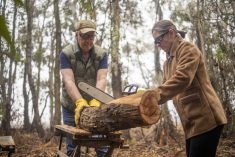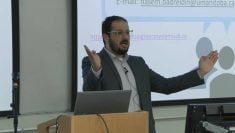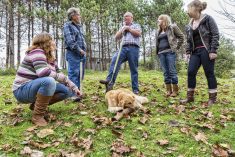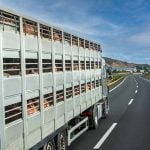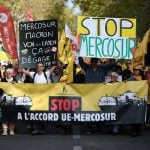A couple we’ll call Jared, 68, and Leanne, 66, from eastern Manitoba, have built a successful grain farming operation. They have three sons: Josh, 40; Craig, 38; and Shawn, 36. Jared and Leanne want to work toward retirement. The plan is to have Josh and Craig take over. Josh and Craig have both been farming since they were 18 and have built their own successful incorporated farms. Sean will stick with his off-farm career in insurance.
Jared and Leanne have 8.5 quarters of land with a value of $6,500 per acre. Of the 8.5 quarters — that’s 1,360 acres — 760 acres are held personally, and 600 acres are held by their farming corporation. Although they have successors for the farm operation, they want to ensure their sons are treated with an efficient transition of control.
Jared and Leanne approached Nathan Heppner, a chartered financial planner and chartered life underwriter and Erik Forbes, a registered financial planner, each with Forbes Wealth Management Inc. at Carberry, Man., to develop a plan.
Read Also

Gentle treatments for pain in the neck
Heading toward year-end, people unknowingly tense up against the cold and busyness, causing neck pain that can often be treated with appropriate support and gentle mobility, athletic therapist Kathlyn Hossack says.
Jared and Leanne have done an admirable job of building up off-farm assets, with $550,000 in RRSPs and $150,000 in TFSAs. In addition to the land, machinery and inventory inside the corporation, they have $1,100,000 of cash inside the corporation which is not needed for operations. Their ideal solution would be to have as much of the farming assets as possible go to Josh and Craig and all the financial assets, including the cash inside the corporation, go to Shawn. The question then becomes how to get the cash out of the corporation efficiently and fairly.
There are several ways the cash could be taken out of the corporation. The most straightforward way would be to draw down the cash via salary or dividends over the coming years and into the parents’ retirement. This would generate taxable income for Jared and Leanne. However, the corporation is already in a position where there are concerns about its status as a qualified farm business, due to the amount of passive assets in the farming corporation.
A more efficient option would be for Jared and Leanne to sell land they now hold personally to the corporation, for a value equal to or greater than the cash they want to strip out. Doing it at a greater value would give them a shareholder’s loan that they could use in future if more cash is built up.
Selling land to the corporation would also allow Jared and Leanne to utilize whatever lifetime capital gains exemption they have. They have never used any of it and after recent changes effective June 25, 2024, they should each qualify for $1,250,000 of exemption. It is worth noting that by moving land into the corporation, it can make it hard and costly to get it out later.
Assuming they take $1,100,000 out of the corporation and put it into their personal names, they can max out their TFSAs and put the rest into a joint non-registered investment account. They have $1,850,000 in personal financial assets they can use to sustain their retirement.
With the cash out of the corporation, Jared and Leanne want to pass the corporate farming operation on to Josh and Craig. This can be done whenever Jared and Leanne deem appropriate, by executing an estate freeze. Jared and Leanne would exchange their common shares in the farm for fixed-value preferred shares and have new common shares issued to Josh and Craig.
Josh and Craig both have their own farming corporations. Therefore, it would be best to have Jared and Leanne’s corporation shifted into Josh’s and Craig’s corporations. In practice it would work as follows:
Valuation and agreement: Obtain accurate third-party valuation for the assets being transferred. An agreement must be reached on the allocation of these assets to ensure each shareholder’s proportional interest is maintained.
Asset transfer: Transfer assets from Jared and Leanne Inc. to Josh and Craig’s own farming corporations. This transfer should be structured to defer taxes. It is important to make sure assets are transferred proportionally to share ownership.
Share exchange: Josh and Craig exchange their shares in Jared and Leanne Inc. for shares in Josh Inc. and Craig Inc. respectively.
Documentation and elections: Prepare and file the necessary documentation — that is, board resolution, shareholders’ agreement and tax elections.
Wind up: The distributing corporation is wound up or its shares are redeemed, completing the split.
With all corporate assets apportioned, cash is stripped out. All that remains is the personally owned land. After what has already taken place, Jared and Leanne believe it would be fair for Shawn to receive one quarter of personally owned land. The remainder would then be split between Josh and Craig. This transfer of ownership can be done at any time between now and the last of Jared and Leanne’s passings. The land can also be passed down at any value between the book value and the current market value. If Jared and Leanne have any lifetime capital gains exemption left, they should use it when passing land on to their sons.
Regardless of the value assigned to the land upon transfer, the parents should put a promissory note structure in place. Doing this will help to protect Jared and Leanne’s interest in the land, should the boys find themselves in financial difficulty or facing an estranged spouse.
Before a creditor or estranged spouse could stake their claim on the land, they would have to pay out Jared and Leanne’s interest. Another benefit of having a quarter of land transferred to Shawn is that it would allow him to utilize his lifetime capital gains exemption if or when he disposes of any land he may acquire.






